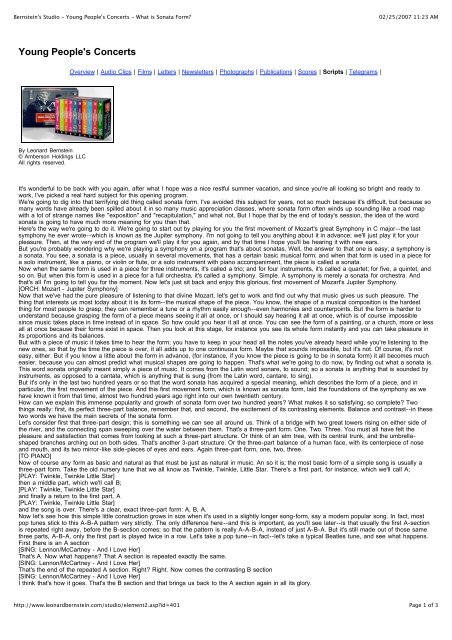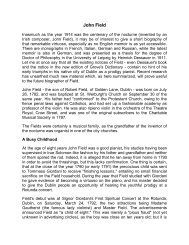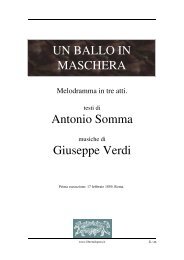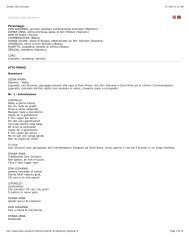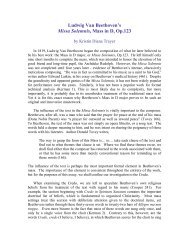Young People's Concerts - What is Sonata Form? - Fulmini e Saette
Young People's Concerts - What is Sonata Form? - Fulmini e Saette
Young People's Concerts - What is Sonata Form? - Fulmini e Saette
You also want an ePaper? Increase the reach of your titles
YUMPU automatically turns print PDFs into web optimized ePapers that Google loves.
Bernstein's Studio - <strong>Young</strong> <strong>People's</strong> <strong>Concerts</strong> - <strong>What</strong> <strong>is</strong> <strong>Sonata</strong> <strong>Form</strong>?<br />
<strong>Young</strong> <strong>People's</strong> <strong>Concerts</strong><br />
By Leonard Bernstein<br />
© Amberson Holdings LLC<br />
All rights reserved.<br />
Overview | Audio Clips | Films | Letters | Newsletters | Photographs | Publications | Scores | Scripts | Telegrams |<br />
http://www.leonardbernstein.com/studio/element2.asp?id=401<br />
02/25/2007 11:23 AM<br />
It's wonderful to be back with you again, after what I hope was a nice restful summer vacation, and since you're all looking so bright and ready to<br />
work, I've picked a real hard subject for th<strong>is</strong> opening program.<br />
We're going to dig into that terrifying old thing called sonata form. I've avoided th<strong>is</strong> subject for years, not so much because it's difficult, but because so<br />
many words have already been spilled about it in so many music appreciation classes, where sonata form often winds up sounding like a road map<br />
with a lot of strange names like "exposition" and "recapitulation," and what not. But I hope that by the end of today's session, the idea of the word<br />
sonata <strong>is</strong> going to have much more meaning for you than that.<br />
Here's the way we're going to do it. We're going to start out by playing for you the first movement of Mozart's great Symphony in C major--the last<br />
symphony he ever wrote--which <strong>is</strong> known as the Jupiter symphony. I'm not going to tell you anything about it in advance; we'll just play it for your<br />
pleasure. Then, at the very end of the program we'll play it for you again, and by that time I hope you'll be hearing it with new ears.<br />
But you're probably wondering why we're playing a symphony on a program that's about sonatas. Well, the answer to that one <strong>is</strong> easy; a symphony <strong>is</strong><br />
a sonata. You see, a sonata <strong>is</strong> a piece, usually in several movements, that has a certain basic musical form; and when that form <strong>is</strong> used in a piece for<br />
a solo instrument, like a piano, or violin or flute, or a solo instrument with piano accompaniment, the piece <strong>is</strong> called a sonata.<br />
Now when the same form <strong>is</strong> used in a piece for three instruments, it's called a trio; and for four instruments, it's called a quartet; for five, a quintet, and<br />
so on. But when th<strong>is</strong> form <strong>is</strong> used in a piece for a full orchestra, it's called a symphony. Simple. A symphony <strong>is</strong> merely a sonata for orchestra. And<br />
that's all I'm going to tell you for the moment. Now let's just sit back and enjoy th<strong>is</strong> glorious, first movement of Mozart's Jupiter Symphony.<br />
[ORCH: Mozart - Jupiter Symphony]<br />
Now that we've had the pure pleasure of l<strong>is</strong>tening to that divine Mozart, let's get to work and find out why that music gives us such pleasure. The<br />
thing that interests us most today about it <strong>is</strong> its form--the musical shape of the piece. You know, the shape of a musical composition <strong>is</strong> the hardest<br />
thing for most people to grasp; they can remember a tune or a rhythm easily enough--even harmonies and counterpoints. But the form <strong>is</strong> harder to<br />
understand because grasping the form of a piece means seeing it all at once, or I should say hearing it all at once, which <strong>is</strong> of course impossible<br />
since music takes place in time instead of in space. So how could you hear it all at once. You can see the form of a painting, or a church, more or less<br />
all at once because their forms ex<strong>is</strong>t in space. Then you look at th<strong>is</strong> stage, for instance you see its whole form instantly and you can take pleasure in<br />
its proportions and its balances.<br />
But with a piece of music it takes time to hear the form; you have to keep in your head all the notes you've already heard while you're l<strong>is</strong>tening to the<br />
new ones, so that by the time the piece <strong>is</strong> over, it all adds up to one continuous form. Maybe that sounds impossible, but it's not. Of course, it's not<br />
easy, either. But if you know a little about the form in advance, (for instance, if you know the piece <strong>is</strong> going to be in sonata form) it all becomes much<br />
easier, because you can almost predict what musical shapes are going to happen. That's what we're going to do now, by finding out what a sonata <strong>is</strong>.<br />
Th<strong>is</strong> word sonata originally meant simply a piece of music. It comes from the Latin word sonare, to sound; so a sonata <strong>is</strong> anything that <strong>is</strong> sounded by<br />
instruments, as opposed to a cantata, which <strong>is</strong> anything that <strong>is</strong> sung (from the Latin word, cantare, to sing).<br />
But it's only in the last two hundred years or so that the word sonata has acquired a special meaning, which describes the form of a piece, and in<br />
particular, the first movement of the piece. And th<strong>is</strong> first movement form, which <strong>is</strong> known as sonata form, laid the foundations of the symphony as we<br />
have known it from that time, almost two hundred years ago right into our own twentieth century.<br />
How can we explain th<strong>is</strong> immense popularity and growth of sonata form over two hundred years? <strong>What</strong> makes it so sat<strong>is</strong>fying, so complete? Two<br />
things really: first, its perfect three-part balance, remember that, and second, the excitement of its contrasting elements. Balance and contrast--in these<br />
two words we have the main secrets of the sonata form.<br />
Let's consider first that three-part design; th<strong>is</strong> <strong>is</strong> something we can see all around us. Think of a bridge with two great towers r<strong>is</strong>ing on either side of<br />
the river, and the connecting span sweeping over the water between them. That's a three-part form. One. Two. Three. You must all have felt the<br />
pleasure and sat<strong>is</strong>faction that comes from looking at such a three-part structure. Or think of an elm tree, with its central trunk, and the umbrellashaped<br />
branches arching out on both sides. That's another 3-part structure. Or the three-part balance of a human face, with its centerpiece of nose<br />
and mouth, and its two mirror-like side-pieces of eyes and ears. Again three-part form, one, two, three.<br />
[TO PIANO]<br />
Now of course any form as basic and natural as that must be just as natural in music. An so it <strong>is</strong>; the most basic form of a simple song <strong>is</strong> usually a<br />
three-part form. Take the old nursery tune that we all know as Twinkle, Twinkle, Little Star. There's a first part, for instance, which we'll call A;<br />
[PLAY: Twinkle, Twinkle Little Star]<br />
then a middle part, which we'll call B;<br />
[PLAY: Twinkle, Twinkle Little Star]<br />
and finally a return to the first part, A<br />
[PLAY: Twinkle, Twinkle Little Star]<br />
and the song <strong>is</strong> over. There's a clear, exact three-part form: A, B, A.<br />
Now let's see how th<strong>is</strong> simple little construction grows in size when it's used in a slightly longer song-form, say a modern popular song. In fact, most<br />
pop tunes stick to th<strong>is</strong> A-B-A pattern very strictly. The only difference here--and th<strong>is</strong> <strong>is</strong> important, as you'll see later--<strong>is</strong> that usually the first A-section<br />
<strong>is</strong> repeated right away, before the B-section comes; so that the pattern <strong>is</strong> really A-A-B-A, instead of just A-B-A. But it's still made out of those same<br />
three parts, A-B-A, only the first part <strong>is</strong> played twice in a row. Let's take a pop tune--in fact--let's take a typical Beatles tune, and see what happens.<br />
First there <strong>is</strong> an A section<br />
[SING: Lennon/McCartney - And I Love Her]<br />
That's A. Now what happens? That A section <strong>is</strong> repeated exactly the same.<br />
[SING: Lennon/McCartney - And I Love Her]<br />
That's the end of the repeated A section. Right? Right. Now comes the contrasting B section<br />
[SING: Lennon/McCartney - And I Love Her]<br />
I think that's how it goes. That's the B section and that brings us back to the A section again in all its glory.<br />
Page 1 of 3
Bernstein's Studio - <strong>Young</strong> <strong>People's</strong> <strong>Concerts</strong> - <strong>What</strong> <strong>is</strong> <strong>Sonata</strong> <strong>Form</strong>?<br />
02/25/2007 11:23 AM<br />
[SING: Lennon/McCartney - And I Love Her]<br />
Well, that's a small step forward from Twinkle, Twinkle, Little Star, it's small, but it's a step. It's grown in size, and it has that extra deluxe feature--the<br />
repeat of the first A section, which Twinkle, Twinkle does not. Now let's follow the growth of a three-part song even further, as it expands into a big<br />
operatic aria--for example, the famous aria from Carmen that <strong>is</strong> sung by the other woman, Micaela. Th<strong>is</strong> <strong>is</strong> a little more soph<strong>is</strong>ticated; it doesn't break<br />
up quite so neatly into an exact A-B-A but I'm sure you'll be able to follow its three parts, just as easily as the Beatles song: the sweet, lyrical first part<br />
the more excited and dramatic middle part, and the return again to the quiet first part. And here to sing it for us <strong>is</strong> M<strong>is</strong>s Veronica Tyler, who made her<br />
telev<strong>is</strong>ion debut on one of our <strong>Young</strong> Performers <strong>Concerts</strong> just a few years ago. We're delighted to have her back with us again singing Micaela's aria<br />
from Carmen.<br />
[ORCH: Bizet - Carmen: Micaels's Aria]<br />
Well, now that we have learned to recognize a three-part song form, which I'm sure we have, I think we're ready to take the plunge into sonata form<br />
itself. Because a typical sonata movement <strong>is</strong> really only a more expanded version of a three-part form, even to the balancing of its two A-sections on<br />
either side of the central B section. And here's where those nasty road map names come in -- I'm sorry but they have to: the first part, or A-section <strong>is</strong><br />
called the exposition: th<strong>is</strong> <strong>is</strong> where the themes of the movement are stated for the first time--or exposed, if you will: therefore the word exposition. Th<strong>is</strong><br />
<strong>is</strong> then followed by a B section, in which one or some or all of those themes are developed in different ways; and so it <strong>is</strong> called the development<br />
section. And finally, just as you expected, we get the A section stated again; and th<strong>is</strong> third part <strong>is</strong> usually called--watch out!-- the recapitulation. Wow,<br />
that's a tough one. Actually, I'm not too crazy about those terms, either but what can we do? We have to use the words that are most commonly used<br />
in order to be understood; so I guess we're stuck with those words - exposition, development, and recapitulation for our A-B-A.<br />
But whatever words we use, the idea of the three parts <strong>is</strong> still clear and simple; the feeling of balance we get from two similar sections situated on<br />
either side of the central development section, just as the ears are situated in a balancing position to the nose. But you remember I said that there<br />
were two main secrets to the sonata; balance, and contrast. And th<strong>is</strong> idea of contrast <strong>is</strong> just as important as the other idea of balance; it's what gives<br />
the sonata form its drama and excitement.<br />
[TO PIANO]<br />
Now how does th<strong>is</strong> contrast take place? I'll show you; and here we're going to have to get technical for a minute or two. But I'm sure you won't mind<br />
that; because what I'm going to show you now <strong>is</strong> very important--in fact th<strong>is</strong> <strong>is</strong> the root of th<strong>is</strong> whole sonata business. And that <strong>is</strong> the sense of key, or<br />
tonality. Most music that we hear <strong>is</strong> written in one key or another; not so much the concert music that's written these days, but most of the music you<br />
are likely to hear <strong>is</strong> written in a key. For instance, the Beatle song we played before <strong>is</strong> in th<strong>is</strong> key:<br />
[SING: Lennon/McCartney - And I Love Her]<br />
That's F-major. But it could also be in G-major:<br />
[SING: Lennon/McCartney - And I Love Her]<br />
Or it could be in C-major:<br />
[SING: Lennon/McCartney - And I Love Her]<br />
or in any of twelve other different major keys. Not twelve others, twelve in all. But whatever key it's in--let's say C-major--you feel a key-note, a<br />
center, or home plate, where the music belongs, starts out from there, and gets back to. That home plate center <strong>is</strong> called the tonic.<br />
[PLAY]<br />
The tonic note <strong>is</strong> the first note of the scale,<br />
[PLAY]<br />
and the tonic chord <strong>is</strong> the chord you build on to that note.<br />
[PLAY]<br />
Now all the other notes of the scale also have names; but I won't bother you with them except for th<strong>is</strong> one, which I'd like you to remember: the<br />
dominant. That's the name given to the fifth note of any scale--<br />
[PLAY AND COUNT]<br />
1, 2, 3, 4, 5 --in th<strong>is</strong> key of C-major the fifth note happens to be G<br />
[PLAY]<br />
and the dominant chord <strong>is</strong> the chord that's built on that note.<br />
[PLAY]<br />
That's the dominant. Now comes the main event--how these two key-centers, the tonic and the dominant, are related to each other. If I play a tonic<br />
and a dominant chord, in that order, what do you feel?<br />
[PLAY]<br />
Something <strong>is</strong> left unfin<strong>is</strong>hed, unresolved, <strong>is</strong>n't it? You feel a desperate urge to get back to the tonic, where you started, don't you?<br />
Okay--let's play them in reverse order--dominant to tonic<br />
[PLAY]<br />
and now you feel sat<strong>is</strong>fied, don't you? So you see, that tonic <strong>is</strong> like a magnet; you can pull away from it, going to all kinds of other chords,<br />
[PLAY]<br />
other keys, or tonal centers; but in the end the tonic always pulls you back.<br />
[PLAY]<br />
And out of th<strong>is</strong> magnetic pull, away from and back to the tonic, classical sonata form <strong>is</strong> built. That's where the drama lies, the tension--in the contrast<br />
of keys with one another. Let's see how th<strong>is</strong> works in an actual piece of music by Mozart.<br />
The composer will naturally begin h<strong>is</strong> sonata in the key of the tonic, and h<strong>is</strong> opening theme will be in that key, as in th<strong>is</strong> famous C-major <strong>Sonata</strong> by<br />
Mozart. Here's the main theme.<br />
[PLAY: Mozart - <strong>Sonata</strong> in C major]<br />
But now, like a magician, he begins to lure us away from the tonic to a new key--the dominant.<br />
[PLAY: Mozart - <strong>Sonata</strong> in C major]<br />
There we are in the dominant key--G-major.<br />
[PLAY: Mozart - <strong>Sonata</strong> in C major]<br />
And in th<strong>is</strong> new key Mozart gives us a new theme, h<strong>is</strong> second theme, which goes like th<strong>is</strong>:<br />
[PLAY: Mozart - <strong>Sonata</strong> in C major]<br />
and then finally, still in the key of G-major, he gives us a little fanfare-like tune with which he closes the exposition.<br />
[PLAY: Mozart - <strong>Sonata</strong> in C major]<br />
So there we are, solidly establ<strong>is</strong>hed in the dominant key of G-major and the exposition part of th<strong>is</strong> movement <strong>is</strong> over.<br />
Now at th<strong>is</strong> point in the classical sonata we usually bump smack into a repeat sign, which means go back to the beginning and play that whole A<br />
Section or exposition you have just heard, all over again. Just like the Beatles: Remember? A-A-B-A. You repeat that phrase. And so for the second<br />
time, we hear the full exposition - first theme, second theme, and closing theme; starting in the tonic and winding up in the dominant. But there's no<br />
point in playing it for you now. You've all just heard it. So you go on to the next section.<br />
Actually th<strong>is</strong> whole exposition we've just heard <strong>is</strong> like a drama, the drama of running away from home--a pulling away from that magnet we call the<br />
tonic. Now the next act coming up, the development, intensifies that drama, wandering even farther away from home, through even more d<strong>is</strong>tant keys,<br />
but then finally giving in and coming home in the third act--or recapitulation. That's the drama of it all. So in the second part, or development section of<br />
th<strong>is</strong> Mozart sonata, the composer lets h<strong>is</strong> imagination roam free; the themes he has stated in the exposition wander around in one foreign key after<br />
another--like a trip around the world. Now because th<strong>is</strong> particular sonata of Mozart's <strong>is</strong> a very short one, the development section <strong>is</strong> also very short. In<br />
fact the only theme Mozart does develop <strong>is</strong> that little fanfare tune we just heard--the closing theme of the exposition<br />
[PLAY: Mozart - <strong>Sonata</strong> in C major]<br />
but now in the development, he puts it through its paces...like th<strong>is</strong>.<br />
[PLAY: Mozart - <strong>Sonata</strong> in C major]<br />
Which brings us to the third and last section of th<strong>is</strong> three-part sonata form--the recapitulation. And th<strong>is</strong> <strong>is</strong> the moment when that magnet we were<br />
http://www.leonardbernstein.com/studio/element2.asp?id=401<br />
Page 2 of 3
Bernstein's Studio - <strong>Young</strong> <strong>People's</strong> <strong>Concerts</strong> - <strong>What</strong> <strong>is</strong> <strong>Sonata</strong> <strong>Form</strong>?<br />
02/25/2007 11:23 AM<br />
talking about finally wins out and draws us back home, to the tonic; and the whole exposition <strong>is</strong> repeated or recapitulated. Only th<strong>is</strong> time we must hear<br />
it all in the tonic key, even the second theme and the closing theme, which we originally heard in the dominant; so that when the movement <strong>is</strong> over, we<br />
are safely at home, in C major where we began.<br />
Of course Mozart, like all geniuses <strong>is</strong> full of surpr<strong>is</strong>es. He doesn't always play the game according to the rules. In fact he often gives us more musical<br />
pleasure by breaking rules than by obeying them. In th<strong>is</strong> C-major <strong>Sonata</strong> of h<strong>is</strong>, where the recapitulation should be in the tonic in the key of C, Mozart<br />
holds out on us; he <strong>is</strong> still res<strong>is</strong>ting that magnet of the tonic; and so he gives us the recapitulation in the unexpected key of F.<br />
[PLAY: Mozart - <strong>Sonata</strong> in C major]<br />
But now Mozart yields, and the magnet wins after all. The rest of th<strong>is</strong> little movement <strong>is</strong> all safe and warm, back home in C-major.<br />
[PLAY: Mozart - <strong>Sonata</strong> in C major]<br />
Now that wasn't too terribly hard, was it? It's certainly hard to play. It sounds easier that it <strong>is</strong>. But it's not very hard to follow the form. Do you see now<br />
what I mean by balance and contrast? The balance of the three-part form (the exposition, the development, and the recapitulation), and the contrast of<br />
the tonic with the dominant. Of course there's much more to it than we can explain in th<strong>is</strong> brief hour: The contrasting key <strong>is</strong> not always in the dominant;<br />
rules get broken right and left. And then there's the whole business of introductions and codas--which means extra sections at the beginning and end<br />
of a sonata movement; but you've got plenty of time to learn about those. <strong>What</strong> matters now <strong>is</strong> that you see the two main things: the magnetic effect<br />
of the tonic, and the A-B-A form. Armed with only that information, you should be able to recognize and follow any classical sonata form movement.<br />
Just to see if I'm right, I'm going to throw you a curve and play you the last movement of Prokofiev's Classical Symphony--a modern work, but a<br />
deliciously spoofing imitation of the 18th-century classical sonata form. It has an exposition cons<strong>is</strong>ting of a first theme in the tonic, a second theme in<br />
the dominant, and a closing theme in the dominant. Then that whole exposition section <strong>is</strong> repeated exactly; then a development section in which these<br />
themes are tossed around; and then finally the recapitulation which <strong>is</strong> the whole exposition again, only all in the tonic. It <strong>is</strong> a perfect example: sonata<br />
form at its simplest and clearest A-B-A. See if you can follow it.<br />
[ORCH: Prokofieff - Classical Symphony]<br />
I hope I was right in thinking you were able to follow the form of that movement by Prokofiev. If I was wrong, you'll have another chance in a moment<br />
to try your luck. If I was right, you are well on your way toward being a real music l<strong>is</strong>tener. Because, as I said before, anyone can enjoy a tune or a<br />
rhythm, that's easy. To enjoy the form of a piece of music <strong>is</strong> much harder. Then you have to be a real music l<strong>is</strong>tener. But a real music l<strong>is</strong>tener can<br />
see or hear the form of a piece just as clearly as a person can see the three-part form of a bridge.<br />
Now, confident that you are all new experts on the subject of sonata form, we're going to keep our prom<strong>is</strong>e and play for you the opening movement<br />
again of the Jupiter Symphony with which we began th<strong>is</strong> program, the great C-major symphony. Only th<strong>is</strong> time, because th<strong>is</strong> particular movement <strong>is</strong> so<br />
much more expanded--so much more fully developed and elaborate than the movements we've been l<strong>is</strong>tening to--we have decided to enl<strong>is</strong>t the aid of<br />
these nine young students from The Mannes College of Music, who are holding up blank signs at the moment.<br />
Now, what they're going to do, <strong>is</strong> as the music unreels itself, as each new section comes up, these nine charming youngsters, who as you can see<br />
have formed for you a very clear 3-part form already, are going to announce each section in turn, by turning the sign around. If any of you still have<br />
doubts about sonata form, these sign-bearers should clear them up for you. The only other thing I have to tell you about before we play <strong>is</strong> that for<br />
reasons of time we will not obey the repeat sign at the end of the exposition. Instead of being Beatles A-A-B-A, we're going to be just plain A-B-A.<br />
Otherw<strong>is</strong>e, you're on your own; and I hope you do indeed hear th<strong>is</strong> piece now with new ears.<br />
[ORCH: Mozart - Jupiter Symphony]<br />
More Scripts: "Fidelio": A Celebration of Life | A Birthday Tribute to Shostakovich | A Toast to Vienna in 3/4 Time | A Tribute to Sibelius |<br />
Aaron Copland Birthday Party | Bach Transmogrified | Berlioz Takes a Trip | Charles Ives: American Pioneer | Fantastic Variations (Don<br />
Quixote) | Farewell to National<strong>is</strong>m | Fidelio: A Celebration of Life | Folk Music in the Concert Hall | Happy Birthday, Igor Stravinsky | Happy<br />
Birthday, Igor Stravinsky | Humor in Music | Jazz in the Concert Hall | L<strong>is</strong>zt and the Devil | Musical Atoms: A Study of Interval | Quiz Concert:<br />
How Musical Are You? | The Anatomy of a Symphony Orchestra | The Latin American Spirit | The Sound of an Orchestra | Two Ballet Birds |<br />
<strong>What</strong> does Music Mean? | <strong>What</strong> <strong>is</strong> a Concerto? | <strong>What</strong> <strong>is</strong> a Melody? | <strong>What</strong> <strong>is</strong> a Mode? | <strong>What</strong> <strong>is</strong> American Music? | <strong>What</strong> <strong>is</strong> Classical<br />
Music? | <strong>What</strong> <strong>is</strong> Impression<strong>is</strong>m? | <strong>What</strong> <strong>is</strong> Orchestration? | <strong>What</strong> <strong>is</strong> <strong>Sonata</strong> <strong>Form</strong>? | Who <strong>is</strong> Gustav Mahler? |<br />
http://www.leonardbernstein.com/studio/element2.asp?id=401<br />
Page 3 of 3


